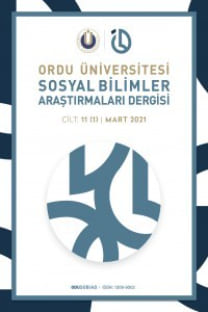Opus Dei: Papalığın Şahsi Piskoposluğu
Hıristiyanlık, Katolik Kilisesi, Papalık, Opus Dei, Josemaría Escrivá de Balaguer
Opus Dei: A Personal Prelature of Papacy
Christianity, Catholic Church, the Papacy, Opus Dei, Josemaría Escrivá de Balaguer,
___
- Agamben, G. ve Kotsko, A. (2013). Opus Dei: An Archaeology of Duty. Stanford: Stanford University Press.
- Allen, J. L. (2006). Opus Dei / Katolik Kilisesinin İçindeki Güç ve Gizemler (Ş. Mercan, Çev.). İstanbul: Nokta Yayınları. Bauer, C. (2016). Secret Society Opus Dei: Catholicism’s Secret Sect. New York: Maplewood Publishing.
- Boston, R. (2006, Mayıs). Breaking the Opus Dei Code. Church & State, 104-109. https://search.ebscohost.com/login.aspx?direct=true&db=edsgao&AN=edsgcl.145981250&lang=tr&site=eds-live
- Casanova, J. V. (1982). The Opus Dei Ethic and the Modernization of Spain [Unpublished Doctoral dissertation] New School for Social Research, New York.
- Condon, J. (1957). The Secular Institutes and the Opus Dei. Studies: An Irish Quarterly Review, 46(181), 106-108. https://www.jstor.org/stable/30098861
- Cummings, D. (1976). The Founder of Opus Dei. The Furrow, 27(9), 539-542. https://www.jstor.org/stable/27660212 De Balaguer, J. E. (2006). The Way. London: Scepter Publishers.
- De Balaguer, J. E. (2008). Conversations with St. Josemaría Escrivá. London: Scepter Publishers.
- De Los Reyes, G. ve Rich, P. (2005). Opus Dei and Mexico: Civil but Sinister? Review of Policy Research, 22(1), 93-101. http://doi.org/10.1111/j.1541-1338.2005.00121.x
- ISSN: 1309-9302
- Yayın Aralığı: Yılda 3 Sayı
- Başlangıç: 2010
- Yayıncı: -
Kurumsal Yönetim ve Finansal Performans: Borsa İstanbul Üzerine Bir İnceleme
Yasin KILIÇLI, Emrullah KIPÇAK
Ateizmden Teizme: Bir Vaka İncelemesi
Akademisyenlerin Dijital Okuryazarlık Hakkındaki Görüşlerinin İncelenmesi
Hacı Mehmet YEŞİLTAŞ, Meral ÇELİKOĞLU, Gökhan DAĞDALAN, Göknur AYDIN, Murat ÇETİNKAYA
Depreme Karşı Okul Binalarında Yapısal Olmayan Tehlikelere Alternatif Mobilya Tasarım Önerileri
Ortaokul Öğrencilerinin Problem Çözme Becerileri ile Eleştirel Düşünme Becerileri Arasındaki İlişki
Gürbüz OCAK, Elif BAHÇEĞİL YAZICIOĞLU, Akın KARAKUYU
Otizmli Çocuklar İçin Giysi Modifikasyon Uygulamaları Kılavuzu
Saliha USLU TANDOĞAN, Neşe ÇEĞİNDİR
Yiyecek İçecek İşletmelerinde Örgütsel Stres Faktörleri Üzerine Bir Araştırma
Investigation of Solid Waste Collectors with Economic and Social Dimensions
